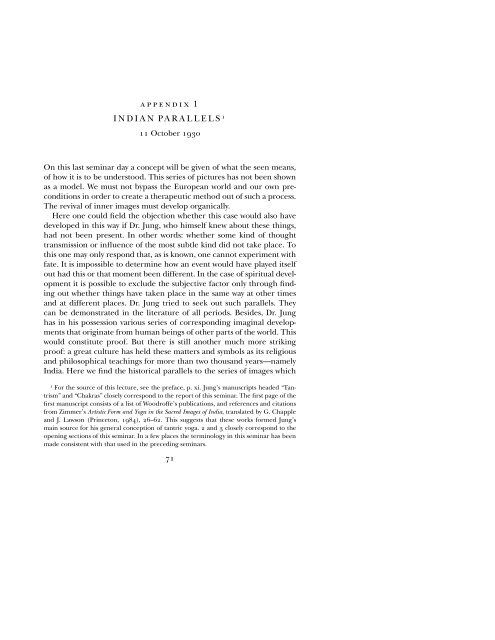CG JUNG - Countryside Anarchist
CG JUNG - Countryside Anarchist
CG JUNG - Countryside Anarchist
You also want an ePaper? Increase the reach of your titles
YUMPU automatically turns print PDFs into web optimized ePapers that Google loves.
APPENDIX 1<br />
INDIAN PARALLELS 1<br />
11 October 1930<br />
On this last seminar day a concept will be given of what the seen means,<br />
of how it is to be understood. This series of pictures has not been shown<br />
as a model. We must not bypass the European world and our own preconditions<br />
in order to create a therapeutic method out of such a process.<br />
The revival of inner images must develop organically.<br />
Here one could field the objection whether this case would also have<br />
developed in this way if Dr. Jung, who himself knew about these things,<br />
had not been present. In other words: whether some kind of thought<br />
transmission or influence of the most subtle kind did not take place. To<br />
this one may only respond that, as is known, one cannot experiment with<br />
fate. It is impossible to determine how an event would have played itself<br />
out had this or that moment been different. In the case of spiritual development<br />
it is possible to exclude the subjective factor only through finding<br />
out whether things have taken place in the same way at other times<br />
and at different places. Dr. Jung tried to seek out such parallels. They<br />
can be demonstrated in the literature of all periods. Besides, Dr. Jung<br />
has in his possession various series of corresponding imaginal developments<br />
that originate from human beings of other parts of the world. This<br />
would constitute proof. But there is still another much more striking<br />
proof: a great culture has held these matters and symbols as its religious<br />
and philosophical teachings for more than two thousand years—namely<br />
India. Here we find the historical parallels to the series of images which<br />
1 For the source of this lecture, see the preface, p. xi. Jung’s manuscripts headed “Tantrism”<br />
and “Chakras” closely correspond to the report of this seminar. The first page of the<br />
first manuscript consists of a list of Woodroffe’s publications, and references and citations<br />
from Zimmer’s Artistic Form and Yoga in the Sacred Images of India, translated by G. Chapple<br />
and J. Lawson (Princeton, 1984), 26–62. This suggests that these works formed Jung’s<br />
main source for his general conception of tantric yoga. 2 and 3 closely correspond to the<br />
opening sections of this seminar. In a few places the terminology in this seminar has been<br />
made consistent with that used in the preceding seminars.<br />
71


